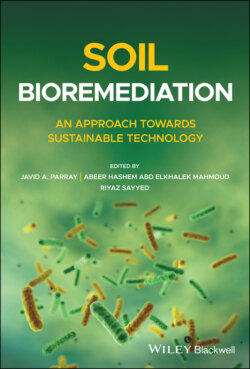Читать книгу Soil Bioremediation - Группа авторов - Страница 2
Table of Contents
Оглавление1 Cover
2 Title Page
3 Copyright Page
4 List of Contributors
5 Preface
6 1 In‐situ Bioremediation: An Eco‐sustainable Approach for the Decontamination of Polluted Sites 1.1 Introduction 1.2 Ex‐situ Versus In‐situ Bioremediation 1.3 In‐situ Bioremediation Techniques 1.4 Conclusion References
7 2 Bioremediation: A Green Solution to avoid Pollution of the Environment 2.1 Introduction 2.2 Sources of Heavy Metals 2.3 Impacts of Heavy Metals on Soil and Microbial Activity 2.4 Fate of Pesticides and Its Biodegradation in Soil 2.5 Strategies of Bioremediation 2.6 Adaptive Mechanism of Bioremediation for Heavy Metals, Pesticides, and Herbicides 2.7 Behavior of Inorganic and Organic Pollutants in Soil 2.8 Environmental Implications of Bioremediation 2.9 Conclusion References
8 3 Laccase: The Blue Copper Oxidase 3.1 What Is Laccase? 3.2 Distribution of Laccases 3.3 Application of Laccase 3.4 Conclusion References
9 4 Genome Assessment: Functional Gene Identification Involved in Heavy Metal Tolerance and Detoxification 4.1 Introduction 4.2 Tolerance and Degradation Mechanisms of Toxic Metals by Microorganisms 4.3 Genetic Engineering in Bioremediation Processes for Some Major Elements 4.4 Biotechnological Intervention for Some Important Heavy Metals 4.5 Future Perspective 4.6 Conclusions References
10 5 Bioremediation of Heavy Metal Ions Contaminated Soil 5.1 Introduction 5.2 Bioremediation 5.3 Phytoremediation 5.4 Analytical Methods in Bioremediation of Metals 5.5 Conclusion References
11 6 Bioremediation of Dye Contaminated Soil 6.1 Introduction 6.2 History and Usage of Dyes 6.3 Classification of Dyes 6.4 Problems Due to Colored Textile Effluent 6.5 Physico‐Chemical Quality of Textile Effluents 6.6 Dye Decolorization/Degradation Techniques 6.7 Factors that Control the Discoloration of Microbial Dye 6.8 Conclusions References
12 7 Composting and Bioremediation Potential of Thermophiles 7.1 Introduction 7.2 Heavy Metal Resistance Genes 7.3 Biotransformation‐Based Bioremediation 7.4 Future Perspectives Acknowledgments References
13 8 Ecological Perspectives of Halophilic Fungi and their Role in Bioremediation 8.1 Introduction 8.2 Hypersaline Inhabitant Fungi 8.3 Strategies Against the Hypersaline Environment 8.4 Ecological Perspectives of Hypersaline Fungi 8.5 Conclusions References
14 9 Rhizobacteria‐Mediated Bioremediation: Insights and Future Perspectives 9.1 Introduction 9.2 Bioremediation: Rescue Plan by Natural Agents 9.3 Rhizoremediation 9.4 Rhizospheric Microbial Community 9.5 Practices that Improves Rhizoremediation 9.6 Future Perspective 9.7 Advantages of Rhizoremediation 9.8 Conclusion Acknowledgment References
15 10 Bioremediation Potential of Rhizobacteria associated with Plants Under Abiotic Metal Stress 10.1 Introduction 10.2 Mode of Action Rhizobacteria 10.3 Bioremediation 10.4 Genetically Modified Plant‐Associated Microbes for Heavy Metal Stress Tolerance 10.5 Highly Toxic Metals 10.6 Effects of Highly Toxic Metals on Plant Growth 10.7 Conclusion References
16 11 Molecular and Enzymatic Mechanism Pathways of Degradation of Pesticides Pollutants 11.1 Introduction 11.2 Effect of Pesticides on Soil Enzymes 11.3 Introduction of Plasmids in Soil Bacteria 11.4 Microbial Degradation of Pesticides 11.5 Enzymatic Degradation 11.6 Organophosphorus Hydrolase and Organophosphorus Dehydrogenase (OPH and OPD) 11.7 Pesticide–Antibiotic Cross Resistance 11.8 Conclusions Acknowledgments References
17 12 Bioremediation of Heavy Metals and Other Toxic Substances by Microorganisms 12.1 Introduction 12.2 Sources of Heavy Metals 12.3 Effects of Heavy Metals on Plant, Microorganisms, and Human Health 12.4 Current Approaches for Remediation of Heavy Metals 12.5 Mechanisms Involved in Bioremediation 12.6 Types of Bioremediation 12.7 Strategies of Bioremediation 12.8 Factors Affecting Bioremediation 12.9 Pros and Cons of Applicability of Bioremediation Approaches Under Field Conditions 12.10 Conclusion and Future Prospects References
18 13 Trends in Heavy Metal Remediation: An Environmental Perspective 13.1 Introduction 13.2 Sources of Heavy Metals 13.3 Heavy Metal Impacts 13.4 Current Scenario of Heavy Metals 13.5 Microorganisms and Remediation of Heavy Metals 13.6 Mechanism of Metal Tolerance by Resistant Species 13.7 Conclusion References
19 Index
20 End User License Agreement
